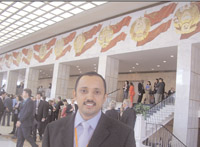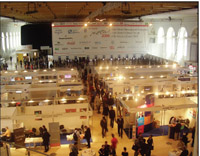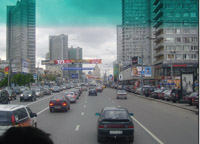
Young readership, Internet and the infamous cartoons discussed at Moscow 2006 Special report on the 59th World Newspaper Congress and the 13th World Editors Forum in Moscow (2-2) [Archives:2006/958/Reportage]
June 26 2006
 |
 |
 |
 |
Moscow hosted the largest gathering of newspaper editors and media executives in its history from 3rd to 8th of June. This is the second part of the report, which highlights some of the interesting issues discussed during the event. These include newspapers in Educations and the debate about the infamous Danish cartoon controversy.
Teenage language
The relationship between newspapers and young readers was one of the most interesting topics discussed in the forum. Anne Kirah, Senior Design Anthropologist at Microsoft Corporation, spoke about how new generations differ from traditional newspaper readers. She presented case studies and a sense of global trends on youth and media today. “We don't understand young people today,” she asserted, stressing that newspapers should change their usual way of thinking about their readers. “They're not users; rather, they are real people with real day-to-day affairs,” she explained.
Kirah noted that today's young readers differ from those of 10 years ago and understanding their needs and adapting to the way they think and see things are essential for newspapers to survive. She pointed out that students in the past weren't allowed to watch TV or listen to music when they came home from school because they had to do their homework. However, children today are different, as they live with a keyboard in one hand and the internet in the other. She added, “They think of the internet as more real than reality itself.”
As for ways to keep new generations attached to newspapers, she explained that newspapers should designate a special place for youth-related issues. Young readers should be able to contribute to such issues and write their own topics. “Newspapers also should adopt teenage language; for example, new codes and icons used by the new generation,” she added.
Engaging newspapers and education
In this session, Roxana Morduchowicz, Director of Media Education at Argentina's Ministry of Education, and Aralynn McMane, Director of WAN's (the World Association of Newspapers) Young Reader programs, explained why it's important to use newspapers in education. They stated that statistics show that daily newspaper readers are those who've used newspapers in their education. Morduchowicz said the idea that a newspaper is a lifetime companion should be promoted in schools.
A successful example of such ideas is El Mundo (Spain's second largest newspaper with a 2003 circulation of 350,297), which has produced a daily Aula supplement for 14- to 18-year-old Spanish students for eight years now.
Tommaso Prennushi, an editor at El Mundo, explained how the supplement consistently has supported itself finically, reaching a readership of 300,000. Using infographics (visual representations of information, data or knowledge), publishing local affairs and exchanging MSM between students were among various techniques enabling it to succeed.
Google, Yahoo and agencies are not enemies
This session examined the impact of new competition from news aggregators and news agencies upon traditional newsrooms, focusing on whether newspapers can adjust their business models to compete in the online world or whether news aggregators and news agencies are destined to dominate internet news.
While many in the newspaper industry perceive Google as a threat to brand recognition, online audiences and advertising revenues, Google's Nathan Stoll believes the opposite is true. “Google News provides advantages for news web sites, journalists and readers,” he said.
Neil Budde of Yahoo! also said his company isn't a threat to newspapers, adding, “In fact, journalistic partnerships are part of the global strategy of Yahoo! News.” He said there's no opposition between traditional and new media, but rather, a symbiotic relationship.
Reuters news agency recently launched a pilot program enabling blogs, news organizations and other online publishers to offer Reuters news videos on their web sites. Dean Wright, Senior Vice President and Managing Editor at Reuters, stated that the agency's new strategy aims to broaden Reuter's audience, boost its brand and take advantage of the growing online advertising market.
Politics, journalism and 'the cartoons'
A special forum session – and the conference's most attended – was dedicated to debating the infamous Danish cartoon controversy and lessons that might be learned from it. In addition to six journalists from different newspapers, two journalists from Jyllands-Posten, the Danish newspaper that published the cartoons, participated in the discussion, namely Editor-in-Chief Joern Mikkelsen and Culture Editor, Fleming Rose, who commissioned the cartoons.
Jyllands-Posten editor-in-chief
The first speaker, Mikkelsen began by listing several things he wanted to clarify in the aftermath of the cartoon affair. He said his newspaper is “not an ultra right-wing newspaper,” nor it is a partner in “an anti-Muslim worldwide movement.” He also stated that the newspaper wasn't seeking to trigger a clash of civilizations. Regarding whether Jyllands-Posten would do it again, he said, “It's hard to say,” adding that “Religions also can be brought up for discussion – it's the only way that society can move forward.”
An Arab view of the event
Khalid Al-Balshy, deputy editor of Egyptian newspaper Al-Destour, spoke about the crisis and how it was exploited badly by Egypt's government and other politicians, as well as by Jyllands-Posten and the Danish government. Al-Balshy said Egyptian government enflamed rather than contained the crisis because it wanted to appear more “Muslim” than its primary opponent – the Muslim Brotherhood – in upcoming parliamentary elections at that time.
He said Egyptians were protesting the cartoons while other important events (a ship sinking and killing more than a thousand people, activists being beaten up, elections being rigged) weren't receiving attention – mainly because “The government wanted it that way.” He asserted that there was a great deal of ignorance on both sides: Jyllands-Posten was ignorant about Islam and the Prophet Mohammed, whereas Muslims were ignorant about freedom of press. Both parties negatively played a part in worsening the matter.
Al-Balshy said Jyllands-Posten should've known that the Prophet Mohammed was a sacred figure and that “They could criticize Islam, but not in this way.” He added that Western media reprinting the cartoons acted irresponsibly and that “The cartoon incident showed that the Western world views the Muslim world as a single entity and vice versa.”
Why do only Muslims react this way?
Eric le Boucher of Le Monde defended his newspaper's decision to publish other Mohammed cartoons. Despite condemning the Danish cartoonists' attempts to link the prophet and terrorism, he said the idea that depicting the prophet is blasphemous is unacceptable. He also claimed that only Muslims react to such things with violence, asking the Muslim world to adopt democracy and accept that there are others who are not Muslims.
Testing the limits and “bad news”Imtiaz Alam, General Secretary of the South Asian Free Media Association in Pakistan, called the Danish experiment “bad news.” He said the Danish newspaper's explanation wasn't convincing and rather unethical because testing the limits of freedom actually has limited freedom of press in his country, as well as in others.
As a result of the cartoons, he said free press now has a bad reputation in his part of the world. This issue wasn't one of free expression, he asserted, but one of purposefully hurting others' feelings.
Newspaper editors' ignorance
Hakim Bello, executive editor of Nigeria's The National Interest newspaper, said ignorance about faith is unacceptable, especially when it comes to editors, whose job is supposed to be based on knowledge.
“We don't submit to taboos”
Rose of Jyllands-Posten claimed the core problem was that everyone was talking about Muslim prohibitions, even though every religion has taboos. He asserted, “It would be disastrous if we had to follow all of them.”
Disappointment rather than lessons
Despite the session's title, “Lessons learned from the Danish cartoon crisis,” and the fact that it was interesting to hear different viewpoints on the issue, many journalists I spoke with afterward expressed disappointment that there actually were no lessons learned. Additionally, many interesting questions the audience asked were ignored, especially those concerning a perceived double-standard by Jyllands-Posten and other Western newspapers in dealing with such sensitive issues. The general feeling was that politics, not journalism, was most speakers' dominating motive, especially Jyllands-Posten journalists.
Expo
Alongside the Congress and Editors Forum sessions, the 2006 Information Services Expo showcased new services and technologies shaping the newspaper of the future. Various media companies exhibited their services related to the newspaper industry with new technologies. To view the exhibitors, visit:
www.moscow2006.com/eng/info_services_expo.
Moscow – a changing lifestyle
This being my first visit to Moscow, it was difficult for me to judge the changes the city has undergone without listening to those who've seen it several times over a long period. To me, Moscow seemed to be heading toward other major European cities in terms of services, shopping centers, etc. While going from place to place, one can't help but notice that most cars on the street are very modern and foreign-made – rarely will one see a Russian-made car. The Western lifestyle dominates, especially among the younger generation.
When I arrived at Domodedovo Airport, I was received by Abdulwahab Nouman, a Yemeni embassy staffer who was a student long ago in what was formerly the Soviet Union. Settling in Russia, he never returned to Yemen.
He told me hundreds – if not thousands – of Yemeni students decided to remain in Russia with their families after becoming disappointed with how Yemen dealt with its qualified citizens returning from abroad. I also met Yemen's ambassador and other Arab ambassadors who attended the congress's opening ceremony at the Kremlin.
From what they said, it seems Russians have a general acceptance and satisfaction about the way President Vladimir Putin is running the country, particularly in the fields of security and economy. “It's safer now than five years ago,” is a comment one can hear from many Russians.
Nouman noted, “Putin is rebuilding good relationships with Arab countries and enhancing Russia's role in the Middle East.” However, he pointed out that everyday Russians aren't happy with the high prices with which they cannot deal.
——
[archive-e:958-v:14-y:2006-d:2006-06-26-p:report]

